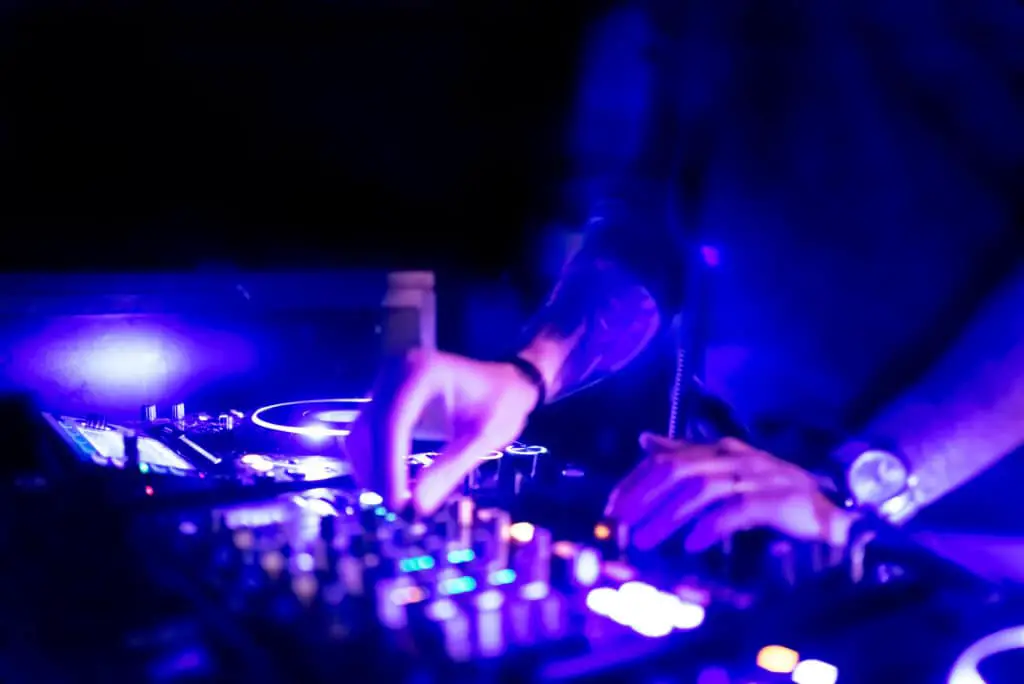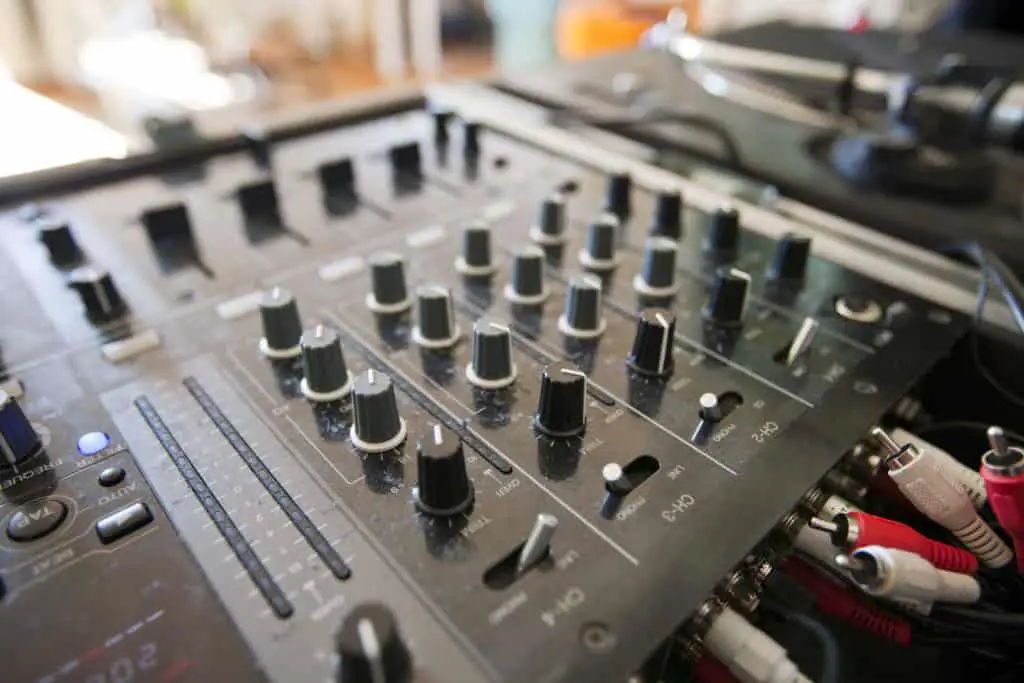If you’ve ever seen a DJ live, you probably know that they’re always doing something. They don’t just hit “play” and expect their playlist to sound perfect. And one of the many things you’ll see a DJ do is turn various knobs. Why?
DJs turn knobs to adjust the equalization (EQ) of a song. As different instruments come in and out of the recording, a DJ may want to change the frequency balance.
The DJ is controlling the listening experience of their audience, similar to how a bandmaster would do so for a big jazz band.
Whether you want to become a DJ or you’re curious about what they’re doing when they perform, you should understand the purpose of knobs. Knobs are how DJs can change the overall sound of a recording, so turning knobs can have a huge effect on the outcome.
Table of Contents
Role of a DJ
Consider the role of a DJ and how turning knobs can play into that. A DJ typically mixes multiple songs one after another to create a playlist. They can perform live or record their mixes in a studio.
And while the equipment a DJ uses has changed drastically over the years, working with knobs has remained. Even though many DJs mix tracks with computers, some still use DJ equipment that contains knobs for different things.
A DJ’s main goal is to entertain their audience, and that involves choosing the right songs for the venue. But some of the best songs for an event may need more editing. Luckily, a good DJ can edit music on the fly so that it better fits the mood of where they’re performing.
Turning knobs typically means the DJ is working with the equalization of the tracks. This means that they can ensure the “vibe” is good for the audience and the space. It can also help when it’s time to transition from one song to the next.

What Is EQ?
Equalization (EQ) lets you change the emphasized frequency levels of the music. You can highlight certain parts, like a big bassline, and you can minimize other tracks within a song. Even if you don’t do much equalizing, turning knobs can make you look like a DJ.
If you want to give your audience the best listening experience, you need to make sure the music works for them. For example, maybe the bass is too quiet in a venue, so you can up the volume on the bass line. Or if the bass is too heavy, you can reduce it so that it doesn’t physically affect where you’re DJing.
Why Adjust the EQ?
Adjusting the EQ means you can change the balance of the tracks within a song. In a live group setting, musicians can listen to each other and change how they’re playing. But when you’re a DJ playing a recording as part of a mix, you can’t tell the guitarist to back off.
So you have to get a bit more creative by editing the tracks and the track volume. Turning the EQ knobs on a DJ mixer is one way to do this. You can adjust other features, like the timbre, or sound quality. A piano and a saxophone can play the same note, but the tonal quality will differ.
If you’re playing a song with a piano and saxophone, you may want to bring out the reedy sound of the saxophone, especially if it has a solo. When working with vocals, you should emphasize those so that the audience can hear the lyrics.
Before you turn EQ knobs in a live setting, you should consider what changes you want to make. In a studio, you can listen back and adjust what you don’t like. But in a live gig, you’ll need to know the precise change you need to get the sound you want.
Small vs. Big Changes
When DJing, you need to determine if the change you want is big or small. If it’s a small change, you can move one knob enough to alter the sound and get what you want. But when it comes to big changes, you may need to go slowly.
Depending on what you want to change, a big edit may shock your audience. Even if they don’t seem to like the original sound, completely bypassing higher frequencies in one second could be confusing.
If you want to focus on the low frequencies, slowly fade out the higher notes until you like what you have.
Changes are one more reason why you should plan out the songs before a gig. You may not know exactly how much you should turn a knob, but you can decide what changes each song may need.
And the better you know the songs, the more you’ll know what changes you should make based on the venue and audience.
One Change vs. Multiple
Another thing to consider is if you can get away with one change to the EQ or if you should always have your hand on the knobs. Sometimes, one change can be great, such as if the overall volume is too low or too high.
On the other hand, adjusting for the tone quality of a specific instrument isn’t always that easy. You’ll have to change the EQ again after the instrument in question is done.
For example, if you want to bring out a saxophone solo, you’ll need to change the EQ when the solo starts and when it ends.
Otherwise, the following music might sound odd and unbalanced. You may also need to frequently adjust the EQ for certain frequencies as they come in and out of a song. So don’t be afraid to keep at least one hand near your EQ knobs at all times.
Transition Between Songs
Some DJs like to mix and edit in the middle of songs, but the most important place to turn knobs is between songs. While a lot of popular songs use similar beat patterns and chords, not all of them do.
Transitioning between songs fluidly can make or break a DJ set. If you play one song and let it go to another without any mixing, make sure the two songs flow together. When you let one song go to another that doesn’t match up, it can change the vibe.
In some cases, you may want to shock your audience. But if you don’t mix the songs together, then you’re not doing much other than playing a playlist. Almost anyone can cue up a list of songs and hit play.
It’s up to the DJ to get creative with a setlist so that everything is consistent. After all, DJs do more than hit play, and the transition between songs is where a DJ can show off their skills.
What if You Don’t See a DJ Turn Knobs?
While turning knobs can make you look like a DJ, you don’t have to do so while performing. If you notice that a DJ doesn’t have a mixer or isn’t changing the knobs, that doesn’t mean they aren’t DJing.
There are a few potential reasons why a DJ might not turn knobs:
- One common reason, especially recently, has been the use of computers. A DJ using a computer might still be controlling the EQ – they just might be changing it in their software instead of on a physical controller.
- You might also not see a DJ turn knobs much if they’ve played in the venue before. In that case, they may know what to expect from the acoustics, so they can program the mix beforehand.
- Similarly, if the DJ uses the same playlist of songs, they may not need to adjust the EQ.
A DJ can turn knobs to adjust the EQ, but they may not need to. Whether they use a computer to change the sound or they have presets for their mix, they can focus on other parts of DJing.
Conclusion
When a DJ turns knobs, they could be doing anything from setting the EQ to looking like a DJ. It doesn’t make one DJ better than another, but it can be a great way to “perform” for the audience. Just be sure you know what you’re doing if you decide to turn knobs while DJing.


![What Happened To “Chief Keef”? [Everything to Know About This Rapper]](https://performerlife.com/wp-content/uploads/2022/05/Chief-Keef-211x150.jpg)
![The Best Way to Use Subwoofers in Apartments: Happy Neighbors! [Subwoofers For Small Apartments]](https://performerlife.com/wp-content/uploads/2022/05/subwoofer-211x150.jpg)
![What Happened To Alex and Sierra? [X Factor Now MISSING?]](https://performerlife.com/wp-content/uploads/2022/05/Alex-and-sierra-211x150.jpg)